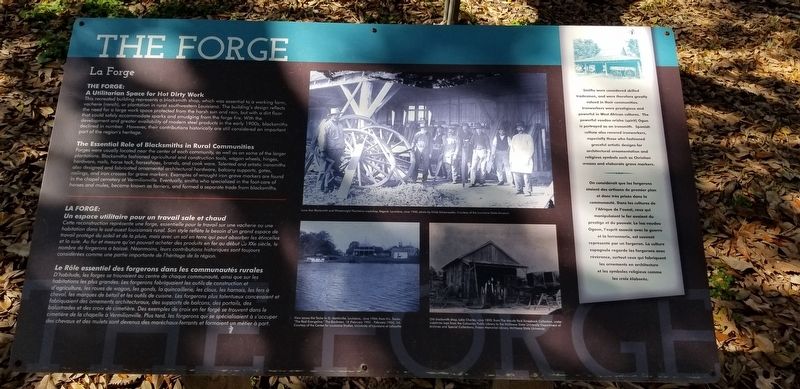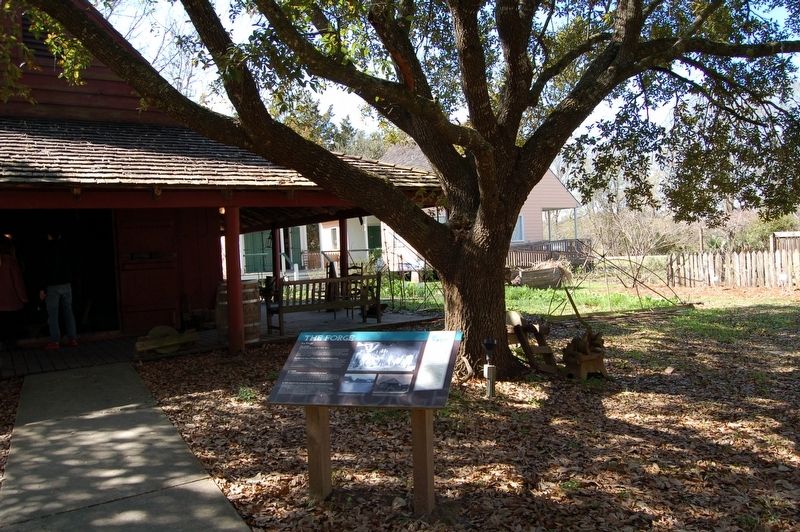The Forge
La Forge
A Utilitarian Space for Hot Dirty Work
This recreated building represents a blacksmith shop, which was essential to a working farm, vacherie (ranch), or plantation in rural southwestern Louisiana. The building's design reflects the need for a large work space protected from the harsh sun and rain, but with a dirt floor that could safely accommodate sparks and smudging from the forge fire. With the development and greater availability of modern steel products in the early 1900s, blacksmiths declined in number. However, their contributions historically are still considered an important part of the region's heritage.
The Essential Role of Blacksmiths in Rural Communities
Forges were usually located near the center of each community, as well as on some of the larger plantations. Blacksmiths fashioned agricultural and construction tools, wagon wheels hinges, hardware, nails, horse tack, horseshoes, brands, and cook ware. Talented and artistic iron also designed and fabricated ornamental architectural hardware, balcony supports, gates, railings, and iron crosses for grave markers. Examples of wrought iron grave markers are found in the chapel cemetery at Vermilionville. Eventually, smiths who specialized in the foot-care of horses and mules, became known as farriers, and formed a separate trade from blacksmiths.
-----------------------------------------------------------------------------------------
Le Rôle essential des forgerons dans les communautés rurales Smiths were considered skilled tradesmen, and were therefore greatly valued in their communities. Ironworkers were prestigious and powerful in West African cultures. The powerful voodoo orisha (spirit) Ogun is portrayed as an ironsmith. Spanish culture also revered ironworkers, especially those who fashioned graceful artistic designs for architectural ornamentation and religious symbols such as Christian crosses and elaborate grave markers. <<<<<<<------->>>>>>>
Un espace utilitaire pour un travail sale et chaud
Cette reconstruction représente une forge, essentielle pour le travail sur une vacherie ou une habitation dans le sud-ouest louisianais rural. Son style reflète le besoin d'un grand espace de travail protégé du soleil et de la pluie, mais avec un sol en terra qua peuit absorber les étincelles et la suie. Au fur et mesure qu'on pouvait acheter des produits en fer ciu debut du XXe siècle, le nombre de forgerons a baissé. Néanmoins, leurs contributions historiques sont taujours considérées comma une partie importante de l'héritage de la région.
D'habitude, les forges se trouvaient au centre de chaque communauté, ainsi que sur les habitations les plus grandes. Les forgerons fabriquaient les outils de construction et d'agriculture, les roues de wagon, les gonds, la quincaillerie, les clous, les harnais, les fers cheval, les marques de bétail et les outils
Erected by Vermilionville Historic Village.
Topics. This historical marker is listed in these topic lists: Agriculture • Colonial Era • Settlements & Settlers.
Location. 30° 12.922′ N, 91° 59.666′ W. Marker is in Lafayette, Louisiana, in Lafayette Parish. Marker can be reached from Fisher Road near Surrey Street (State Road 728-8). Touch for map. Marker is at or near this postal address: 300 Fisher Road, Lafayette LA 70508, United States of America. Touch for directions.
Other nearby markers. At least 8 other markers are within walking distance of this marker. Buller House (a few steps from this marker); Mouton Kitchen (a few steps from this marker); Acadian House (within shouting distance of this marker); The Presbytery (within shouting distance of this marker); Mouton House (within shouting distance of this marker); Trappers Cabin & Boat Shed (within shouting distance of this marker); School House (within shouting distance of this marker); Boucvalt House (within shouting distance of this marker). Touch for a list and map of all markers in Lafayette.
More about this marker. Located on the grounds of the Vermilionville Historic Village, a living history museum. Fee is charged for access to museum grounds.
Credits. This page was last revised on October 26, 2020. It was originally submitted on July 13, 2019, by Cajun Scrambler of Assumption, Louisiana. This page has been viewed 216 times since then and 27 times this year. Photos: 1, 2. submitted on July 13, 2019.

